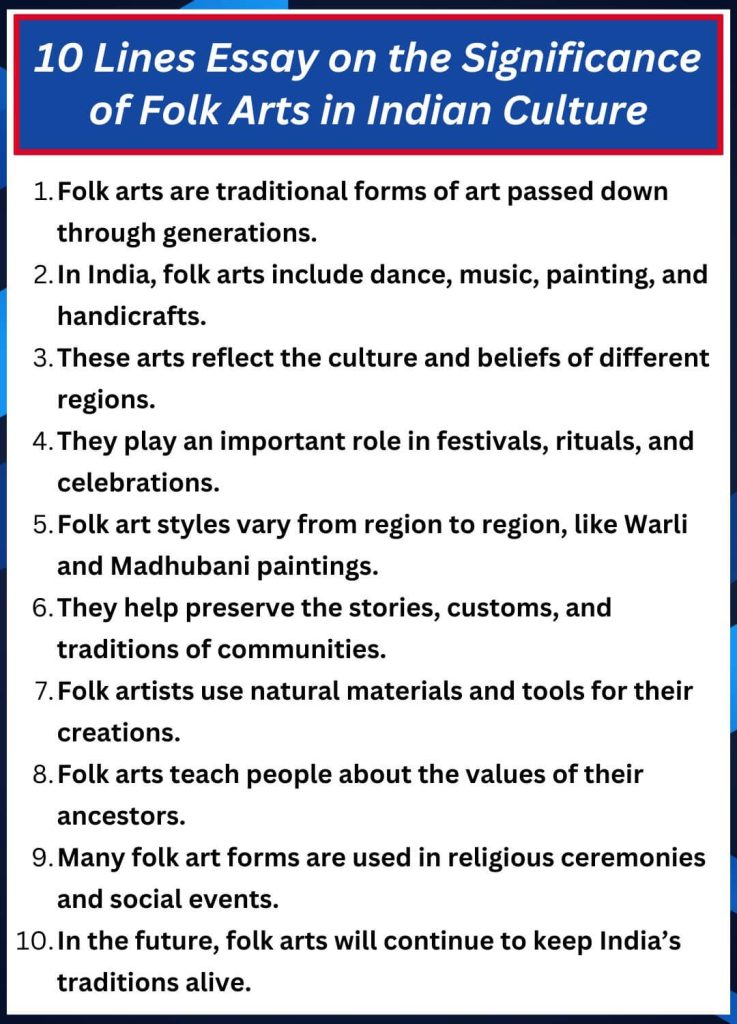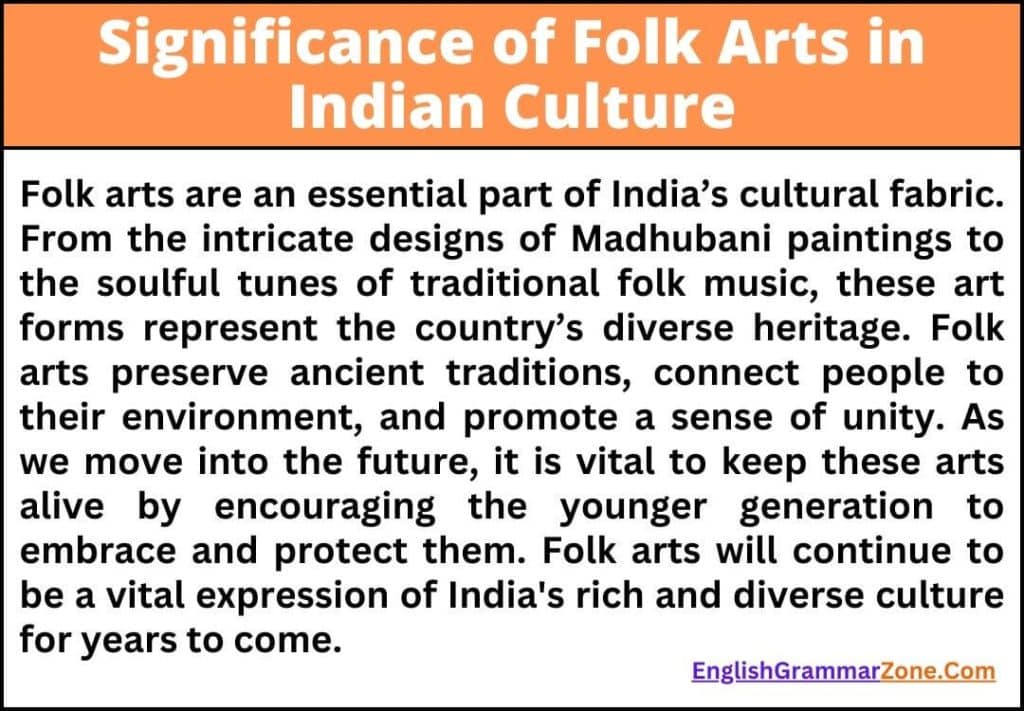Have you ever wondered about the colorful paintings or the rhythmic beats of traditional instruments you hear during festivals? These are part of India’s vibrant folk arts, which carry deep cultural meanings and stories. Folk arts are not just artistic expressions; they are windows into India’s diverse heritage. In this article, we will learn how to write an essay on the significance of folk arts in Indian culture and why they are so important to our history and identity.
10 Lines Essay on the Significance of Folk Arts in Indian Culture
- Folk arts are traditional forms of art passed down through generations.
- In India, folk arts include dance, music, painting, and handicrafts.
- These arts reflect the culture and beliefs of different regions.
- They play an important role in festivals, rituals, and celebrations.
- Folk art styles vary from region to region, like Warli and Madhubani paintings.
- They help preserve the stories, customs, and traditions of communities.
- Folk artists use natural materials and tools for their creations.
- Folk arts teach people about the values of their ancestors.
- Many folk art forms are used in religious ceremonies and social events.
- In the future, folk arts will continue to keep India’s traditions alive.

Short Essay on the Significance of Folk Arts in Indian Culture
India is home to a rich tradition of folk arts that have been passed down from one generation to the next. These arts include various forms such as dance, music, painting, and crafts, each representing the culture of different regions. The folk arts are not just about beautiful creations; they tell stories of the people, their beliefs, and their way of life.
For example, Warli paintings from Maharashtra depict nature and daily life using simple geometric patterns. Madhubani paintings from Bihar are known for their intricate designs that tell stories from mythology. These art forms play an important role in festivals, rituals, and social events. Whether it’s the dances performed during Diwali or the music played during weddings, folk arts create a sense of community and help celebrate shared traditions.
Folk arts also help preserve the history and customs of different regions. Artists use local materials, such as clay, wood, and natural dyes, to create their work, ensuring that each piece is connected to its environment. This connection to nature and tradition keeps the art form authentic and rooted in the community’s values.
In the future, it is important to preserve these folk arts so that new generations can continue to enjoy and learn from them. Folk arts teach us about the beauty of diversity and the importance of keeping our cultural heritage alive.
Long Essay on the Significance of Folk Arts in Indian Culture
India is a land of diverse cultures, languages, and traditions. Among the many cultural expressions, folk arts stand out as a crucial part of India’s identity. Folk arts include a wide range of creative expressions such as dance, music, painting, and craftwork. These arts are not only beautiful but also deeply tied to the beliefs, customs, and history of different regions in India.
Folk arts in India have always been an important way for people to communicate their stories, express emotions, and celebrate their culture. For example, in Rajasthan, the traditional folk dance form of Ghoomar is performed during festivals and social gatherings, showcasing the vibrant culture of the region. Similarly, the musical traditions of Indian folk music, such as the Baul singers of Bengal, carry messages of love, spirituality, and the connection between the human soul and the divine.
One of the most notable aspects of Indian folk arts is their diversity. Every state in India has its own unique art forms, representing the values, beliefs, and lifestyles of its people. In the north, the art of Phulkari embroidery from Punjab reflects the rural lifestyle and the beauty of nature. In the south, the Kuthu Villu dance of Tamil Nadu uses storytelling to narrate mythological tales. Similarly, in eastern India, Odisha’s Pattachitra paintings capture the stories of Lord Jagannath and other deities.
The significance of folk arts extends beyond just entertainment or decoration. These art forms serve as a bridge between the past and the present, preserving ancient traditions while adapting to modern times. Folk arts play a critical role in religious ceremonies, weddings, and social events, adding color and life to celebrations. In many rural communities, folk artists still use their craft to maintain spiritual connections and cultural continuity.
Moreover, folk arts are deeply connected to the natural environment. Traditional artists often use materials that are locally available, such as mud, bamboo, and natural dyes. This not only makes the art more sustainable but also strengthens the bond between the people and the land they live on. Through folk arts, communities continue to honor their surroundings and protect the environment.
However, in today’s fast-paced world, many folk art forms are at risk of disappearing. Modern technology, urbanization, and changing lifestyles are challenging the survival of these age-old traditions. It is important for the younger generation to learn about and appreciate these art forms so that they can be preserved for future generations. Many organizations and artists are working hard to revive and promote folk arts, ensuring that these traditions are not lost.
In the future, folk arts will continue to play a key role in Indian culture. They will inspire new forms of artistic expression while remaining a symbol of India’s rich and diverse heritage. As we move forward, it is our responsibility to keep these traditions alive, celebrating them for their beauty, history, and the stories they tell.

FAQs of Essay on the Significance of Folk Arts in Indian Culture
1. What are folk arts in India?
Folk arts in India refer to traditional art forms passed down through generations. These include dance, music, painting, crafts, and other creative expressions. Each art form reflects the culture, traditions, and lifestyle of different regions in India. Some popular examples include Warli paintings from Maharashtra, Kathakali dance from Kerala, and Madhubani paintings from Bihar.
2. Why are folk arts important in Indian culture?
Folk arts are important in Indian culture because they preserve the stories, beliefs, and customs of various communities. They connect people to their heritage, making them an essential part of festivals, ceremonies, and daily life. Folk arts also foster a sense of unity and help people celebrate their shared cultural identity.
3. How do folk arts preserve Indian traditions?
Folk arts preserve Indian traditions by maintaining ancient techniques and storytelling methods. For example, the traditional art of embroidery in Punjab (Phulkari) and the use of natural materials in crafts like pottery or painting keep the link between art, nature, and culture alive. Folk arts serve as living expressions of a community’s values, which are passed on from one generation to the next.
4. Can folk arts be used in modern times?
Yes, folk arts can be used in modern times. Many artists today are blending traditional techniques with contemporary styles to create new art forms. For instance, folk paintings may be used in modern decor, and folk music may be adapted into popular songs. By blending the old with the new, folk arts continue to evolve while staying true to their roots.
5. How can we preserve folk arts for the future?
To preserve folk arts for the future, it is important to educate young people about these traditions and encourage them to practice and promote them. Supporting local folk artists, organizing festivals, and using social media to showcase folk art can also help keep these traditions alive. Furthermore, by creating platforms for folk artists to showcase their work, we can ensure that these traditions are not lost.
Top 5 Quotes on Folk Arts
- “Folk art is the mirror of the community’s soul.” – Unknown
- “Every piece of folk art tells a story that cannot be heard in words.” – Unknown
- “Art is not what you see, but what you make others see.” – Edgar Degas
- “The greatest art is not necessarily the one with the highest technique, but the one that brings people together.” – Unknown
- “Folk art is an authentic representation of culture and tradition, reminding us of who we are.” – Unknown
Summary of Essay on the Significance of Folk Arts in Indian Culture
Folk arts are an essential part of India’s cultural fabric. From the intricate designs of Madhubani paintings to the soulful tunes of traditional folk music, these art forms represent the country’s diverse heritage. Folk arts preserve ancient traditions, connect people to their environment, and promote a sense of unity. As we move into the future, it is vital to keep these arts alive by encouraging the younger generation to embrace and protect them. Folk arts will continue to be a vital expression of India’s rich and diverse culture for years to come.

